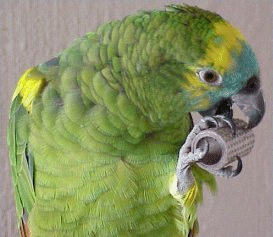Amazon Parrots
| Species NameAmazona aestiva
A. finschi A. autumnalis A. festiva A. xanthops A. barbadensis A.ochrophala aurophalliata A. amazonica A. farinosa A. ochrocephala oratrix A. albifrons |
Common Name Lilac-crowned amazon Red-lored amazon Festive amazon Yellow-faced amazon* Yellow-shouldered amazon* Yellow-naped amazon Orange-winged amazon |
| *Not seen as pets very oftenFollow linked names to see photographs and species-specific information. | |
Amazon parrots comprise many parrots that range in size from the small spectacled (white-fronted) amazon to the quite sizable double yellow-headed and mealy amazons. They are more challenging pets and many species are more appropriate for people experienced with handling parrots. Some males can become aggressive when they reach sexual maturity. Gentle dominance training is essential. It is a good idea to teach amazons to step up on a stick on command for those times when they are “overstimulated.” These birds require strong, patient owners who understand their moods. Do plenty of research on behavior and training before buying one so you can build a strong foundation with the young bird.
Generally, the best talkers are double yellow heads, yellow napes, and blue fronts. Many of these birds can also become proficient singers. They are not shy and will often perform for strangers. Because of these characteristics, these parrots are often selected as performers in bird shows and at zoos.
Amazons tend to be more independent birds and can amuse themselves much of the day if they are given adequate toys and space. It is a good idea to give them a tower with many perches and toys for exercise and amusement. Generally, they do not develop feather picking problems the way many parrot species do, but they can if they are neglected, confined in small cages for long periods of time, and not stimulated with interaction and/or toys.
Caging: The larger the cage the better. Amazons are quite active and very prone to obesity if they do not get exercise. Cages should be give adequate room for play and exercise. Spacing of bars depends on the size of the species. Make sure for smaller amazons the spacing is not large enough for them to get their head through.
Diet: Watch the fat. Pellets (medium/large), fresh vegetables, some fruit, sprouts, and grains (quinoa especially). Seeds and large nuts, but not as the primary source of nutrition. Calcium important for blue fronts. DO NOT give grit to this or any other parrot species.
Health: Tendency toward obesity and related health issues. Lifespan is generally 40-80 years depending on the species, but obesity can drastically reduce this (up to 70%). Have an avian vet weigh your bird annually to make sure it is not gaining an unhealthy amount of weight.
Amazons should be showered regularly for feather and skin health. They can develop a musky odor that bothers some people, but most become used to it quickly. Regular showers keeps the smell from getting too strong. Most amazons adore being soaked to the skin with a mister.
Noise: Most birds bought young and properly trained and socialized will rarely vocalize to the point of disturbing neighbors, but generally they do vocalize atleast once a day with loud screeches. Some amazons can be very loud. Many older birds are sold and re-sold because of calls that can be heard for quite a distance. They are not great for apartments for this reason.Obviously, the larger the bird, the louder the call. Amazons that have been kept with other amazons tend to be the loudest.
Sleep: At least 10 hours of dark, quiet sleep time each night. Amazons that do not get enough sleep can be very grouchy and aggressive.
Sexual behavior: Males can become very aggressive when hormonal. Age this occurs depends on the species, but generally at 3-5 years of age. Springtime is the most obvious period to watch for this. It is best to train amazons to stand on your hand and NOT on your shoulder because of their unpredictability during “mating season.” It is important to learn to recognize their moods and not pick up an amazon when its eyes are flashing and the tail is flared.
Breeding: Need very large flights as males can be extremely aggressive toward females in many species. Not for the beginner.










